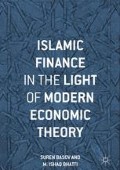The previous chapter illustrated that our intuition is not a very reliable guide when it comes to designing complex policies and that formal analysis is often needed. The issue of tax burden, though important, is of no direct relevance to the theory and practice of Islamic finance (IF). The example we consider in this chapter, how the value of the firm is affected by the way it is financed, is of direct relevance to IF. When you decide to start a business, one of your first questions is likely to be how to raise the money to finance your operations. Broadly, there are two ways to raise funds: taking debt or issuing equity. Debt financing, however, requires one to pay interest to the lender, typically a bank. Islamic law prohibits charging interest or entering into a contract that requires one to pay interest. Is such a requirement a significant handicap for Islamic businesses?
Access this chapter
Tax calculation will be finalised at checkout
Purchases are for personal use only
Notes
- 1.
At some periods x t may be negative, which we will interpret as investment.
- 2.
Value D i should be interpreted as a present value of debt obligations, which will require the payment rD i per period.
- 3.
This example is from Milgrom and Roberts (1992).
- 4.
Allowing her to borrow only a fraction of P 0 and use her own funds to pay the rest will not change the argument.
- 5.
We assume that there is no uncertainty concerning the value of P 1.
- 6.
Again, the bank can buy a share of the house, while the individual buys the rest. The rent will be adjusted accordingly. These complications do not concern us here.
References
Basov, S., and M.I. Bhatti. 2011. Social norms and economic performance: An example of business loans by Islamic banks. SSRN Electronic Journal, http://papers.ssrn.com/sol3/papers.cfm?abstract_id=1968702.
Derigs, U., and S. Marzban. 2009. New strategies and a new paradigm for Sharia’a-compliant portfolio optimization. Journal of Banking and Finance 33: 1166–1176.
Miller, M., and F. Modigliani. 1958. The cost of capital, orporation finance and the theory of investment. American Economic Review 48: 261–297.
Milgrom, P., and J. Roberts. 1992. Economics, organization and management. Englewood Cliffs: Prentice-Hall.
Author information
Authors and Affiliations
Copyright information
© 2016 The Author(s)
About this chapter
Cite this chapter
Basov, S., Bhatti, I. (2016). The Basics of Corporate Finance: The Miller–Modigliani Theorem. In: Islamic Finance in the Light of Modern Economic Theory. Palgrave Macmillan, London. https://doi.org/10.1057/978-1-137-28662-8_5
Download citation
DOI: https://doi.org/10.1057/978-1-137-28662-8_5
Published:
Publisher Name: Palgrave Macmillan, London
Print ISBN: 978-1-137-28661-1
Online ISBN: 978-1-137-28662-8
eBook Packages: Economics and FinanceEconomics and Finance (R0)

